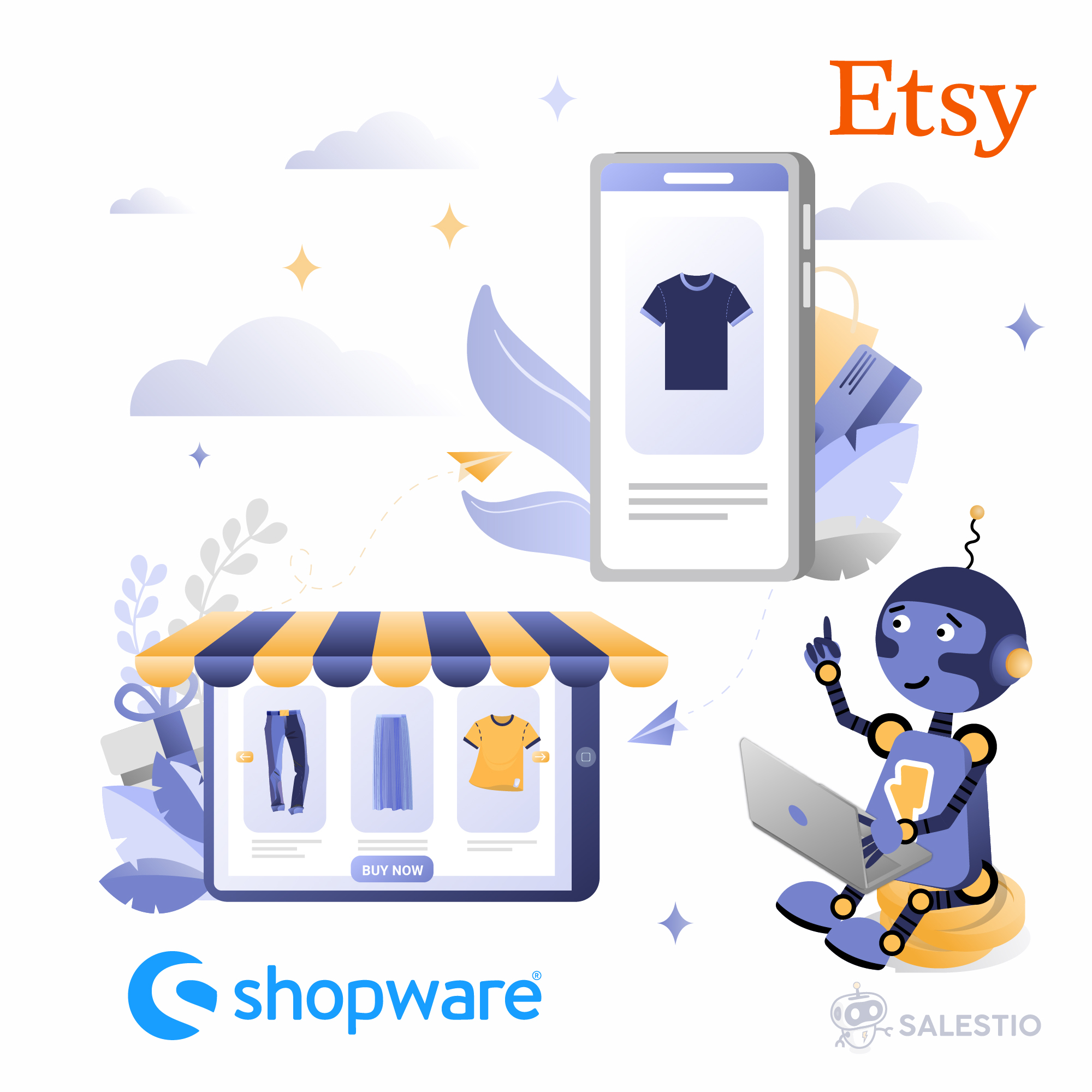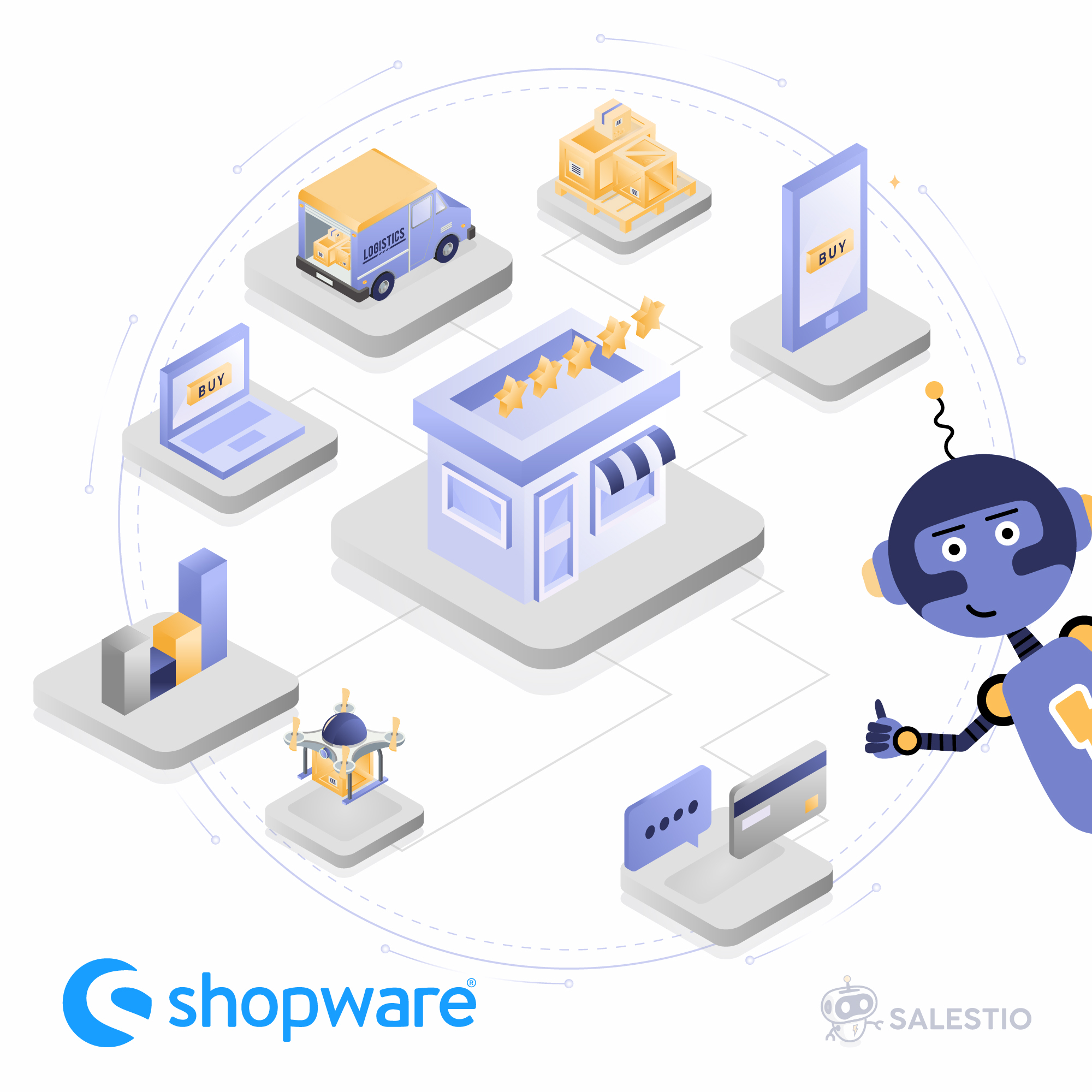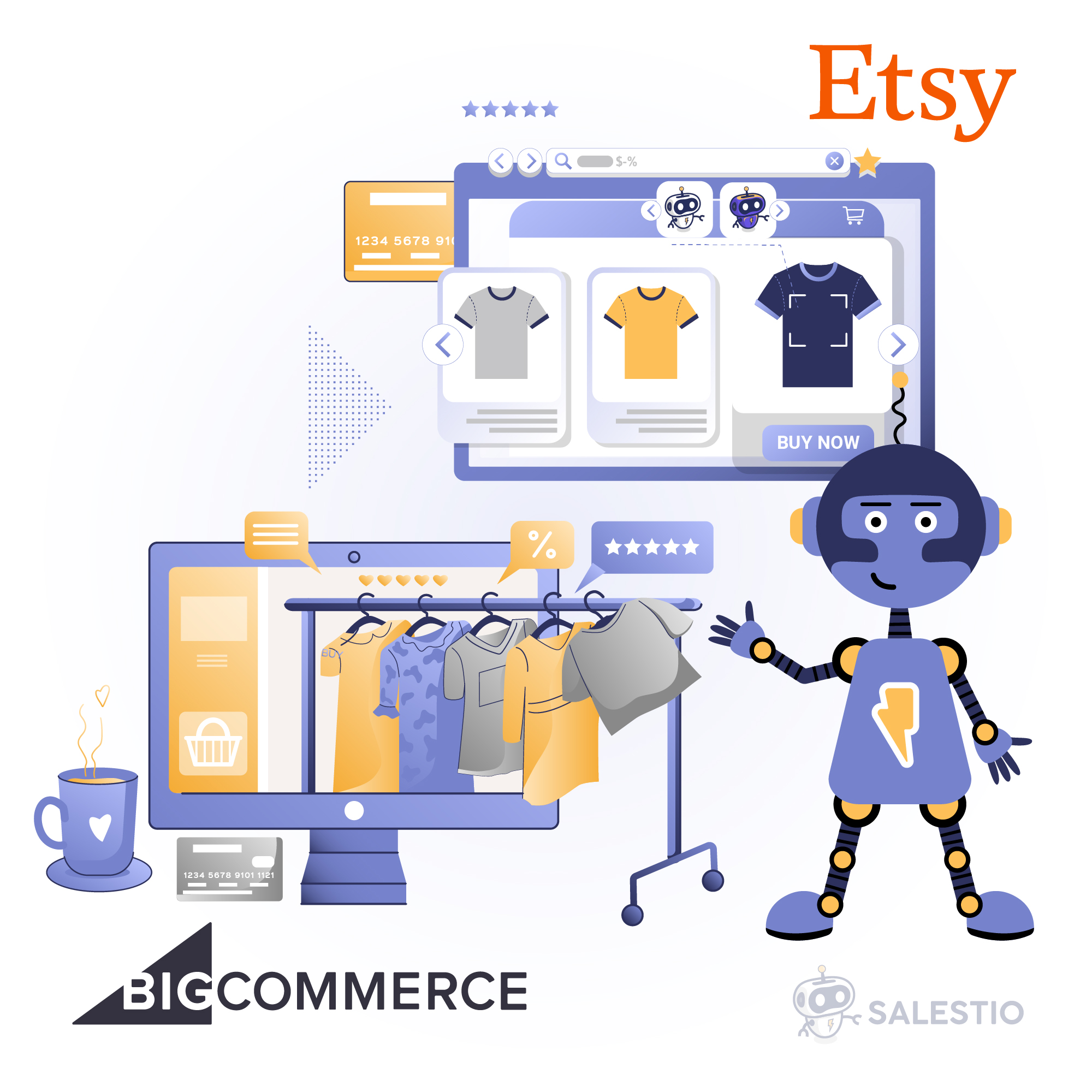04 Jul'25

Salestio provides a variety of services to synchronize data between Shopify and eBay. Whether you are an experienced user or just starting with Salestio, you might have some questions. This FAQ covers answers to the most common questions and provides helpful links when possible.
- Sending products to eBay
- How do I send my products to eBay?
- How do I add Business Policies?
- How to customize eBay descriptions?
- How to connect to custom categories from eBay Store
- Is “Listing creation data” required?
- My items have an error status. What do I do?
- What to do with an “Adjust Creation Profile” error?
- It says that the Location and Postal Code are missing. Where do I add them?
- Managing products through Selling Lists
- Connecting with active eBay inventory
- Quantity and price sync
- Order synchronization
Sending products to eBay
How do I send my products to eBay?
Sending products to eBay involves the following steps:
- Configure a Creation Profile.
- Add an Ebay Profile (optional). This profile is used as a template holding some of the listing-related options. You can skip this step and change the settings directly in Selling List settings later.
- Create a Description Template (optional). The default template will use the original Shopify description on eBay. You can customize the product description in Salestio > Profiles > Description templates.
- Create a Selling List (Salestio > Profiles > Add Selling List).
- Add products to the Selling List by assigning categories (Collection mode) or adding individual items (Product mode).
- Select the products and click the “Send to eBay” action.
Follow the full guide below for detailed steps and more tips:
Exporting Shopify Products to eBay Marketplace with Salestio
How do I add Business Policies?
Sellers can create customized templates for their shipping, payment, and return policies. These templates allow sellers to specify details such as shipping methods, handling times, accepted payment methods, and return periods.
Before Business Policies can be selected in the Selling List, they should be configured directly on eBay. After the policies are added, they will appear on the Selling List configuration page.
eBay handles Business Policies separately for each marketplace. If you created a set of policies on ebay.it, they will not be available if you select Germany marketplace in the Selling List. To resolve this, check if you selected the right marketplace in the Selling List and added policies on the right website (ebay.de for Germany, ebay.it for Italy, etc.)
Read the full article:
Using eBay Business Policies with Salestio
How to customize eBay descriptions?
You can change how the final eBay description will look by editing the Description template in Salestio > Profiles > Descriptions templates. The editor allows using the original Shopify information, like titles, descriptions, and images, as well as any metafields added to the items, to compose the final result.

Inside the description section, eBay allows sellers to use almost any HTML tags and CSS, providing significant flexibility in detailing product, payment, and shipping information. To get more tips for creating the perfect description, check the full article below:
eBay Description Templates: Make Beautiful Descriptions Faster
How to connect to custom categories from eBay Store
Subscribers of the eBay Store program have access to custom categories on their storefront. Salestio supports this feature with Store mapping profiles found in Salestio > Profiles > Store mapping profiles.
This profile allows setting up a connection between Shopify Product types/Collections/Categories and the custom sections of your eBay store.
Read more about configuring and using Store mapping profiles.
Is “Listing creation data” required?
Selling Lists feature a “Listing creation data” section for every item to offer more flexibility in configuring the products. Adding information here is optional.
If you skipped adding a Creation Profile or want to overwrite it for a specific item, the creation data, like eBay category and item specifics, can be added here.

My items have an error status. What do I do?
To find out more about the error, check the logs for the affected item. Click “Logs” and look for the latest messages. Logs indicate if some information is missing, a seller account needs an update, or if there is an issue in the app configuration.
Full article: List on eBay: Common errors and how to fix them

What to do with an “Adjust Creation Profile” error?
In some cases, when the Creation Profile is misconfigured, you may receive the error below:
Error during submitting Selling Product with the title [Your Product Title] to Ebay. Ebay category not found for product, please adjust Creation ProfileThis error means that the corresponding mapping or Creation Profile is not found. Follow the stepa below to make sure that the profiles are configured correctly:
- Note the Shopify Category, Product Type, and Collections on the product in question. Check the mapping in the Creation Profile and make sure that the Conditions section satisfies the noted item properties.
For example, the mapping can be set to match “all conditions” with two collections selected: “spring jackets” and “winter jackets”. If the item is added to only one of the collections, change the settings to match “any condition”.
Remember to save the mapping and the Creation Profile after making changes.

- Check the Ebay Profile (if you didn’t add one, check the “Ebay Profile” section in Selling List settings).
Make sure that product creation is enabled and the correct Creation Profile is selected. Save the profile after making changes.

- Go to Selling List settings and check if the correct Ebay Profile is selected there.
- Send the product to eBay again.
It says that the Location and Postal Code are missing. Where do I add them?
Item Location is always required. You may get the following error withiout specifying the needed details:
Error during submitting a product to eBay. Please add the Item LocationTo resolve this, check the Ebay Profile or Selling List settings and add the missing details in the “Additional Shipping Details” section:

Managing products through Selling Lists
How to update eBay listings in Salestio?
Salestio offers a few ways of updating the items. Revise Price and Revise QTY allow manually updating price and stock without changing the other details. Revise Quick performs both actions at the same time.
For items in “Linked” status, this update is performed automatically as soon as a change is detected in Shopify, so the above action are just a way to force the update.
When some of the product details are changed in Shopify, Salestion can update the eBay listing according to the current settings. To update an item, select it in the Selling List and run the Full Revise action. This will update the images, titles, descriptions, as well as quantity and price.
Unlike price and quantity, this update can only be performed manually. If you want to push some product changes to eBay, use the Full Revise action when needed.

How can eBay stock be updated to 0?
To stop the listings manually, select the item in the Selling List and run the “Stop listing” action.
Aside from manual actions, Salestio offers a few settings to control when the listings are stopped automatically. Go to Salestio > Settings and select the connected eBay account from the sidebar. Scroll to the “Item Synchronization” section:

By default, Salestio will stop any sold-out listings. If your items are coming in and out of stock often, consider enabling Out-of-stock control on eBay and disable the “Item Quantity reaches 0 on Shopify” option in Salestio. We have a more detailed explanation and use cases of these options in the article below:
Stop and manage out-of-stock eBay listings through Salestio
Connecting with active eBay inventory
For sellers who have been active on eBay, Salestio can link the existing Shopify inventory with active eBay listings. To connect your eBay inventory with Shopify, please follow the guide below:
Connect Shopify products to existing eBay listings
Do I need to create a Selling List?
Adding a Selling List manually when connecting inventories is an optional step. Id does help if you want to sort the items before linking. If you skip creating a Selling List, the app will automatically add one called “Migrated for *account_name* *marketplace*”.
Products missing from the Inventory tab in Salestio. How do I find them?
Salestio downloads the items from the selected eBay account. This in important to keep in mind when retrieving the list from eBay.
Check the account connection in Salestio and ensure the correct settings. Linked accounts will have an “Active” badge. If the account shows a red badge, try reconnecting it. Click the account in the list, reselect the marketplace, and click “Connect to eBay Account” at the bottom to log in to eBay again.

After confirming the account connection, click “Download inventories” again to get the updated product list.
Why do some items remain Not Linked?
To link the items, Salestio checks if the SKU and account match. Please try the steps below to find out the issue:
- Check if the SKU matches for the eBay – Shopify item pair. If the SKUs are different, consider editing them on eBay or in the store, so they match.
Alternatively, configure an SKU Mapping in Salestio to help the app match the different products across platforms. Try linking the items again after adding a mapping or editing the products. - Check if the correct eBay account is selected in the Selling List. This can be viewed from the Selling Lists tab. If the product was placed in a list with incorrect settings, Salestio will also add it to a “Migrated…” Selling list for the respective marketplace/account. Account selection is locked after a Selling List is created. To select something different, please create another Selling List.
- Check if the product structures match between platforms. To link the items, both products should have the same variation options and the same number of variations.
For example, you might have a single Shopify product with 3 variations, whereas it is 3 different listings on eBay. Products like this cannot be linked and should be edited on one of the platforms to match the structure.
Quantity and price sync
Salestio automatically updates the price and quantity for items that have a Linked status in the Selling List. Items will automatically become Linked after they are sent to eBay or connected through the Inventory tab.
How to disable automatic synchronization?
To disable automatic synchronization for price, quantity, or both, go to Salestio > Settings tab. Select the eBay account in the sidebar to access the sync settings:

How do you customize the quantity values sent to eBay?
Go to Salestio > Profiles > Global Profiles to change the settings.
“Item QTY Mode” and “Item QTY Value” are used to set the rules for quantity synchronization. “Product” mode is the default, and it uses the Shopify values. As one of the options, you can use the “Custom” mode to set the quantity at a constant value.
Automatic quantity synchronization is disabled in “Custom” mode. Check the article below for detailed explanation of each mode.
Learn more: How to Manage Listing Quantities with Salestio
How do you customize the prices sent to eBay?
Go to Salestio > Profiles > Global Profiles to change the settings.
“Price Mode” and “Price Value” are used to set the price rules for product synchronization. To evenly increase or decrease the prices, change the Price ratio, which will multiply the Shopify price.
Price rounding can also be enabled in the Global Profile. Check the available options under “Price Smart Rounding” to customize how the prices look.
To set up complex price formulas, try using Price Templates:
Custom Pricing Rules for Ebay and Amazon Listings
Why are my items not syncing?
Items have to be in the Linked status to receive automatic updates. Try the steps below to troubleshoot:
- Confirm that automatic synchronization is enabled in the Salestio settings.
- Check the status in the Selling List and make sure it is Linked.
- Review Global Profile settings and see if the QTY mode is selected correctly.
Check the more detailed steps in the post below:
Troubleshoot quantity synchronization issues in Salestio
My listings are exceeding the eBay limit. Is there a way around this?
Some eBay sellers can have a limit on how many items they can list each month. Trying to list more will result in the following error:
This listing would cause you to exceed the amount you can list. You can list up to $30.00 more in total sales this month.To resolve this, you can decrease the quantity of the item in the store and try listing/updating it again.
With Salestio, you can limit the quantity automatically by changing the Global Profile settings. To set a limit, go to the active Global Profile, change “Item QTY Mode” to “Not more than” and “Item QTY Value” to the maximum stock that you want to see.
More tips about managing selling limits: Selling limits on eBay explained: possible solutions
Order synchronization
Salestio starts importing orders automatically after an eBay account is connected. All the orders are created in Shopify after they appear in Salestio > Orders tab.
The Shopify orders are created based on the SKUs of the items. Salestio matches the SKU to create a link to the Shopify product and check if the quantity is sufficient to create the order.
To check if any issues appear with an order, find it in Salesito > Orders > click the target eBay order ID. Any relevant errors appear on the timeline at the bottom of the order view page in Salestio. To receive email notifications about failed orders, enable the option in Salestio > Settings.
Check the full guide about everything related to order import
How to send fulfillment to eBay?
Salestio sends a status update and tracking number back to eBay without extra steps. After the Shopify order is fulfilled, the eBay side will receive an update shortly.
What to do when orders don’t appear in Shopify?
If an order does not appear in Shopify or other issues appear, try the following steps to diagnose the problem:
- Find the order in Salestio > Orders tab.
If the order is missing, check if the account is Active in Salestio > Accounts. Make sure that the order is Paid on the marketplace. - Open the Salestio order.
- Scroll down to the timeline to look for possible error messages.
The below error might appear when the ordered marketplace item has a different SKU in Shopify:
Missing products in Shopify: SKU: example-product-2To resovle this momentarily, scroll up and click “Change” on this item. Select the correct Shopify item in the list and save the changes. Salestio will try creating this order again automatically (you can also click “Export” to create the order ASAP).

To prevent the error from appearing on future orders, edit the Shopify or eBay SKU to match. This way, Salestio will be able to tell how to match items automatically.
To keep SKUs different, consider setting up a SKU mapping. With a mapping, you can set corresponding Shopify and eBay SKUs in a table. Check more details and a quick step-by-step in our guide.
Another issue that can prevent creating the order in Shopify is insufficient stock:
Error during export order #111-1111111-1111111 in Shopify. Line_items Unable to reserve inventory.To resolve this, increase the Shopify stock, and Salestio will retry creating the order. As another option, enable the “Continue selling when out of stock” option on the Shopify product page.
To avoid overselling and keep the quantities synced across all platforms, link them through Salestio (check the tips in the above sections of this article).
If you have any unanswered questions, feel free to reach out to the team at support@salest.io, and we will do our best to help. Check out Salestio on the Shopify App Store.





